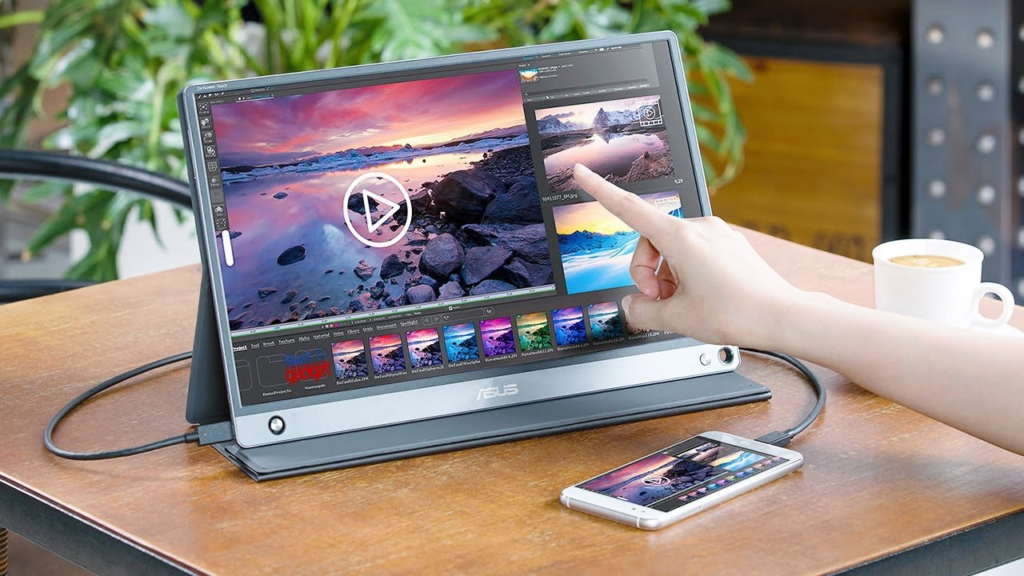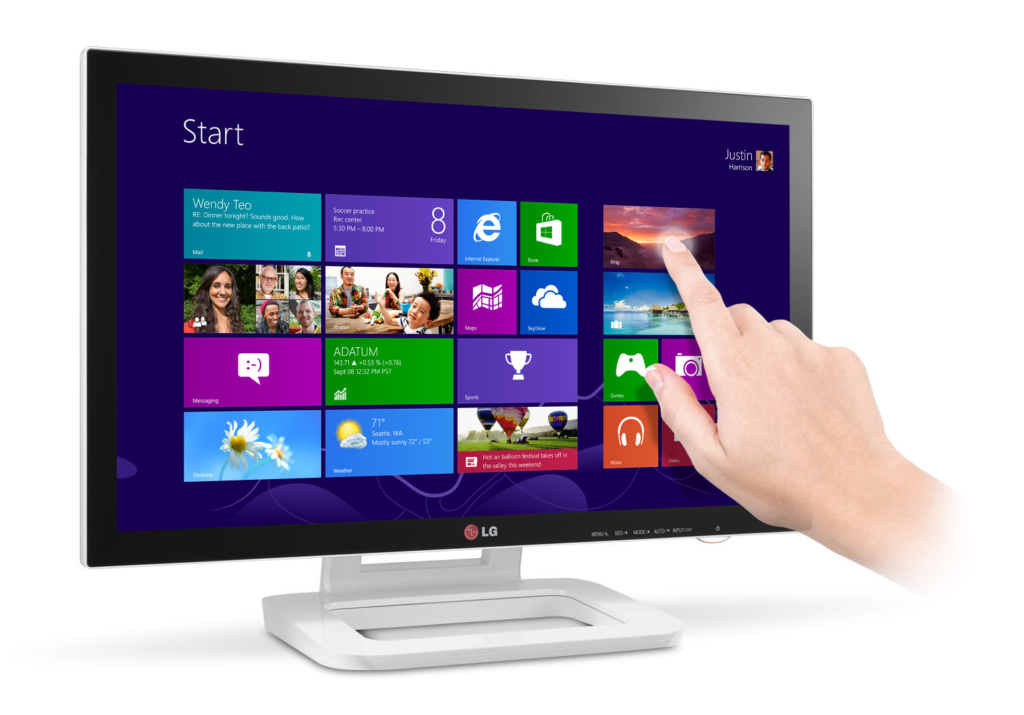Touchscreen technology has revolutionized how we interact with devices. Initially confined to smartphones and tablets, this intuitive interface is now making its way to laptops, thanks to touch monitors. These external displays offer a unique blend of traditional computing and the tactile experience of touchscreens, enhancing productivity and creativity.

Understanding Touch Monitors
A touch monitor is essentially a computer monitor equipped with a touchscreen. It connects to your laptop via HDMI, DisplayPort, or USB-C, providing an extended workspace. While some laptops come with built-in touchscreens, external touch monitors offer larger screen sizes and often better touch accuracy.
Benefits of Using a Touch Monitor with Your Laptop
- Enhanced Productivity:
- Multitasking: Seamlessly switch between applications with a simple touch.
- Precision Work: Fine-tune images, videos, or documents with precise touch controls.
- Intuitive Navigation: Explore operating systems and software with natural gestures.
- Creative Boost:
- Digital Art and Design: Create stunning visuals with touch-based drawing and painting apps.
- Photo and Video Editing: Make precise adjustments with intuitive touch controls.
- Content Creation: Develop engaging presentations and interactive content.
- Improved User Experience:
- Immersive Gaming: Enjoy games with touch-based interactions and controls.
- Educational Tools: Interactive learning experiences for students and educators.
- Accessibility: Provide easier access for users with disabilities.
Types of Touch Monitors
- Resistive Touchscreens:
- Rely on pressure to register touch input.
- Affordable but less accurate and responsive.
- Suitable for basic touch applications.
- Capacitive Touchscreens:
- Detect electrical charges from the user’s finger.
- Highly accurate, responsive, and multi-touch capable.
- Commonly used in high-end touch monitors.
- Surface Acoustic Wave (SAW) Touchscreens:
- Detect changes in sound waves caused by finger contact.
- Durable and resistant to scratches and liquids.
- Often used in public settings.
Key Features to Consider
When choosing a touch monitor, consider the following features:
- Screen Size: Determine the ideal size based on your workspace and usage.
- Resolution: Opt for high resolution for crisp visuals and detailed work.
- Touch Technology: Choose capacitive touchscreen for optimal performance.
- Connectivity: Ensure compatibility with your laptop’s ports (HDMI, DisplayPort, USB-C).
- Response Time: A low response time reduces lag for smooth touch interactions.
- Viewing Angles: Wide viewing angles allow for comfortable viewing from different positions.
Setting Up Your Touch Monitor
Connecting a touch monitor to your laptop is generally straightforward:
Check Compatibility: Ensure your laptop’s graphics card and operating system support external monitors.
Connect Cables: Use the appropriate cables to connect the monitor to your laptop.
Install Drivers: Install any necessary drivers for the monitor to function correctly.
Calibrate Touchscreen: Follow on-screen instructions to calibrate the touchscreen for accurate touch input.
Tips for Optimal Use
- Keep Screen Clean: Fingerprints and smudges can affect touch sensitivity.
- Use Stylus: For precise work, consider using a stylus.
- Explore Touch Gestures: Learn and utilize various touch gestures for efficient navigation.
- Experiment with Apps: Discover touch-optimized apps to enhance your experience.
Common Issues and Troubleshooting
- Touchscreen Unresponsiveness: Check for obstructions, recalibrate the touchscreen, and update drivers.
- Ghost Touches: Clean the screen, avoid using multiple fingers, and try a different stylus.
- Display Issues: Verify cable connections, adjust display settings, and check for compatibility.
The Future of Touch Monitors
Touch monitors are continually evolving with advancements in display technology, touch sensitivity, and integration with AI. We can expect to see more innovative features, such as gesture recognition, haptic feedback, and even holographic displays in the future.
In conclusion, touch monitors offer a compelling blend of traditional computing and intuitive touch interactions. By carefully considering your needs and preferences, you can select the perfect touch monitor to enhance your productivity and creativity.

FAQ’S
What is a touch monitor?
A touch monitor is a display screen that you can interact with using your fingers or a stylus. Unlike traditional monitors that rely on a mouse and keyboard, touch monitors offer a hands-on approach, allowing you to tap, swipe, and pinch to control your laptop.
Do I need a special laptop to use a touch monitor?
No, most modern laptops can be connected to a touch monitor. All you need is the necessary cables (usually HDMI or DisplayPort) and compatible drivers. Some older laptops might require additional setup or compatibility checks.
What are the benefits of using a touch monitor with a laptop?
There are several advantages to using a touch monitor:
- Improved productivity: Quickly access apps and files with simple gestures.
- Enhanced creativity: Perfect for digital artists, designers, and photographers.
- Better gaming experience: Some games support touch controls for added fun.
- Easier navigation: Enjoy effortless scrolling and zooming.
What are the different types of touch monitors?
There are primarily two types:
- Resistive touchscreens: These respond to pressure, but they might be less accurate and responsive.
- Capacitive touchscreens: More common, they detect electrical charges from your fingers and offer better accuracy and responsiveness.
How do I connect a touch monitor to my laptop?
The connection process is similar to connecting any regular monitor. Typically, you’ll need an HDMI or DisplayPort cable. Some monitors might require additional USB cables for touch functionality. Refer to your monitor’s manual for specific instructions.
Can I use a stylus with a touch monitor?
Yes, many touch monitors support stylus input. This is especially useful for precise tasks like drawing or writing.
Will using a touch monitor affect my laptop’s performance?
Generally, using a touch monitor won’t significantly impact your laptop’s performance. However, demanding tasks like video editing or gaming might require a more powerful system.
Can I use a touch monitor for gaming?
Absolutely! Many games support touch controls, offering a unique gaming experience. However, for fast-paced action games, a mouse and keyboard might still be preferred.
What should I look for when buying a touch monitor?
Consider the following factors:
- Screen size: Choose a size that fits your workspace and needs.
- Resolution: Higher resolution means sharper images.
- Touch technology: Capacitive touchscreens are generally better.
- Response time: Lower response time is essential for gaming and video.
- Connectivity options: Ensure it has the necessary ports (HDMI, DisplayPort, USB).
- Price: Determine your budget and compare features.
Can I convert my existing monitor into a touch monitor?
While there are some DIY solutions available, converting an existing monitor into a touchscreen is generally not practical or cost-effective. It’s often easier and more reliable to purchase a dedicated touch monitor.
How do I clean a touch monitor?
Use a soft, lint-free cloth slightly dampened with a screen cleaning solution. Avoid using harsh chemicals or abrasive materials.
Can I use a touch monitor outdoors?
Most touch monitors are designed for indoor use. Outdoor conditions like sunlight can affect visibility and touch sensitivity.
Are there any specific software requirements for using a touch monitor?
Typically, no additional software is required. Your laptop’s operating system should automatically recognize the touch monitor. However, some touch-specific apps might enhance your experience.
What about touch monitor calibration?
Most touch monitors come pre-calibrated. If you notice inaccuracies, you might need to calibrate it using software provided by the manufacturer.
To read more, Click here